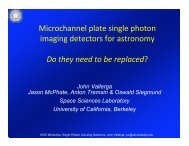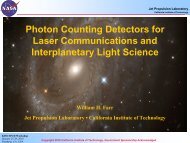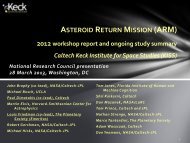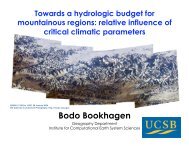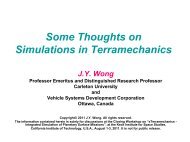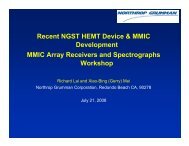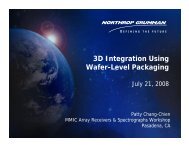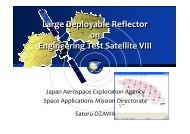Target NEO: Open Global Community NEO Workshop Report
Target NEO: Open Global Community NEO Workshop Report
Target NEO: Open Global Community NEO Workshop Report
You also want an ePaper? Increase the reach of your titles
YUMPU automatically turns print PDFs into web optimized ePapers that Google loves.
DRAFT: RELEASED FOR PUBLIC COMMENTTable 4: <strong>NEO</strong> Survey OptionsOption Observing Location Lead/Concept Bandpass1 Ground LSST VIS-NIR2 L 1 JPL/<strong>NEO</strong>Cam Mid-IR3 L 2 APL/NEST VIS4 Heliocentric @ 0.7 AU APL/NEST VIS5 Heliocentric @ 0.7 AU Ball/<strong>NEO</strong> Survey Mid-IR• Large Synoptic Survey Telescope (LSST) - A 6.4-m optical, ground-based telescopewith a 10 sq deg field of view. LSST, shown in Figure 10(a), will survey the entire visiblesky every 3-4 days in two filters for at least 10 years. LSST is on schedule for full scienceoperations in 2019.• Near Earth Object Camera (<strong>NEO</strong>Cam) - A space-based mid Mid Infrared (Mid-IR)observatory concept, shown in Figure 10(b), that is stationed at Sun-Earth L 1 , where itobserves over a wide range of solar elongation angles. Uses a 50-cm-aperture primary mirror.Both optics and detector are passively cooled. Nominal 4-year mission life.• Near Earth Survey Telescope (NEST) - A space-based visible observatory concept,shown in Figure 10(c) with two mission options: observing from Sun-Earth L 2 or from aheliocentric orbit at approximately 0.7 AU. The L 2 option would observe a “sweet spot”centered latitudinally on the ecliptic, with a solar elongation from 40 ◦ to 70 ◦ . The heliocentricoption observes in opposition. Nominal 2-year mission life.• <strong>NEO</strong> Survey - A space-based Mid-IR observatory concept, shown in Figure 10(d), locatedin heliocentric orbit at approximately 0.7 Astronomical Unit (AU), observing in opposition.Uses a 50-cm-aperture primary mirror. Telescope is passively cooled, and detector is activelycooled. Nominal 2.5-year mission life.6.2 Survey Simulation ResultsTo understand the effectiveness of these options for discovering new <strong>NEO</strong>s, each has been subjectedto a range of survey simulations using models that include observatory performance parameters, asimulated population of target objects extrapolated from the known population, and appropriatenoise sources (e.g., zodiacal light and realistic background confusion limits). Each of these simulationshas been calibrated statistically against the known <strong>NEO</strong> population, so we would expect thesimulation extrapolation to finding undiscovered objects to be robust; overall results presented inthe workshop are shown in Table 5.The simulations of each of the survey options reveal that a dedicated <strong>NEO</strong> survey will increasethe number of HSF accessible targets by at least an order of magnitude [21]. But asa caveat, each of these simulations was produced independently by different institutions, so theyhave not been cross-checked to determine if they give similar results for a common set of surveyspecifications.DRAFT: RELEASED FOR PUBLIC COMMENT 25




